Darabad Museum of Natural History
If you love animals and are curious about animals, a visit to the Darabad Museum of Natural History in Tehran is a must. The Darabad Museum of Natural History is one of the most comprehensive centers in Tehran for showcasing nature and wildlife.
It was established by Tehran’s municipality in 1993 and offers a unique, hands-on experience where visitors can observe the evolution of various species up close. Each section is meticulously designed to reflect the natural habitats and climatic conditions of the species it houses, providing an immersive educational journey.
In this blog, we introduce you to its various sections and share details like its address and visiting hours. For a deeper understanding of the Darabad Museum, stay with us.
Interested in visiting Darabad Museum?
Check out our Tehran tour packages to find an itinerary that includes visiting the museum
or...
Design your own tailor-made itinerary and include Darabad Museum in it by yourself, today!
About the Darabad Museum of Natural History

The Darabad Museum of Nature and Wildlife also known as Iran Wildlife and nature museum is one of Iran's most comprehensive centers for showcasing natural species and wildlife within a specialized and educational museum setting.
The Darabad Museum of Nature and Wildlife, housed in a 2,500 square meter building on a 12,000 square meter plot, offers an extensive exploration of the evolution of all living organisms, including animals, plants, bacteria, and even microscopic creatures. With over hundreds of species, the museum showcases a diverse array of vertebrates and invertebrates.
One of the museum's key attractions is its scientific workshops, educational courses, various exhibitions, and festivals. Additionally, the museum publishes scientific books to enhance public knowledge and understanding of natural history. Visitors can also observe taxidermied animals across different sections of the museum. In the outdoor area, several live animals are housed, providing an even more immersive experience.
The Darabad Museum features more than 26 species of various animals, including carnivores, rodents, reptiles, rabbits, and tigers, alongside 165 bird species out of the 517 identified in Iran.
Among its non-living exhibits is a rare Caspian tiger skin. Additionally, the museum displays two of the rarest and most beautiful endangered mammals: the Persian zebra and the Asiatic cheetah.
| Related: Iran's Wildlife - A Nature Lover's Guide + Pics
History of the Darabad Museum of Natural History
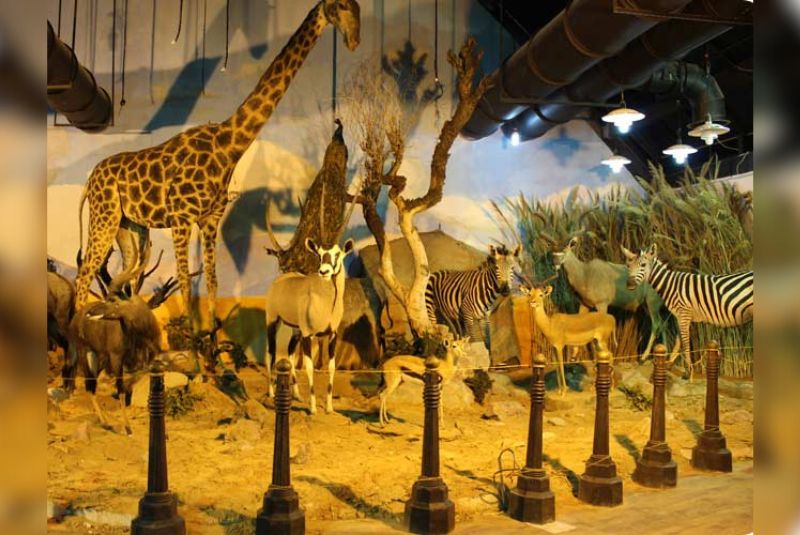
The building that houses the Darabad Museum of Nature and Wildlife was originally a partially completed structure belonging to a member of the Pahlavi era. After the victory of the Islamic Revolution, the Tehran Municipality purchased the building in 1993.
In the shortest possible time, and with significant financial investment and extensive renovations by District 1 of the municipality, this building was transformed into a museum dedicated to Iran's natural history and wildlife.
The establishment of the museum marked a significant step in preserving and showcasing the country's rich biodiversity and natural heritage. Through careful restoration and adaptation, the Darabad Museum became a center for education, research, and public awareness, highlighting the importance of natural history and wildlife conservation in Iran.
| Discover: Best Museums in Tehran - Definitive Guide
Goals of the Darabad Museum of Natural History
The Darabad Museum of Nature and Wildlife has pursued several goals and initiatives over the years, including:
1. Raising Public Awareness:
- Providing general education to the public and establishing close connections with professors, students, and universities in the fields of zoology, botany, environmental science, and geology.
2. Scientific and Practical Workshops:
- Organizing workshops led by both local and international experts to provide hands-on learning experiences.
3. Environmental Education Programs:
- Offering educational courses on environmental topics, nature tours, and scientific visits to enhance knowledge and appreciation of natural history.
4. Publishing Educational Materials:
- Printing and distributing books, brochures, magazines, and educational films to disseminate information widely.
5. Hosting Scientific and Environmental Conferences:
- Organizing conferences for different age groups, including students, to promote scientific and environmental awareness.
| Suggestion: Top 23 Museums in Iran + Photos
Different Sections of the Darabad Museum of Natural History
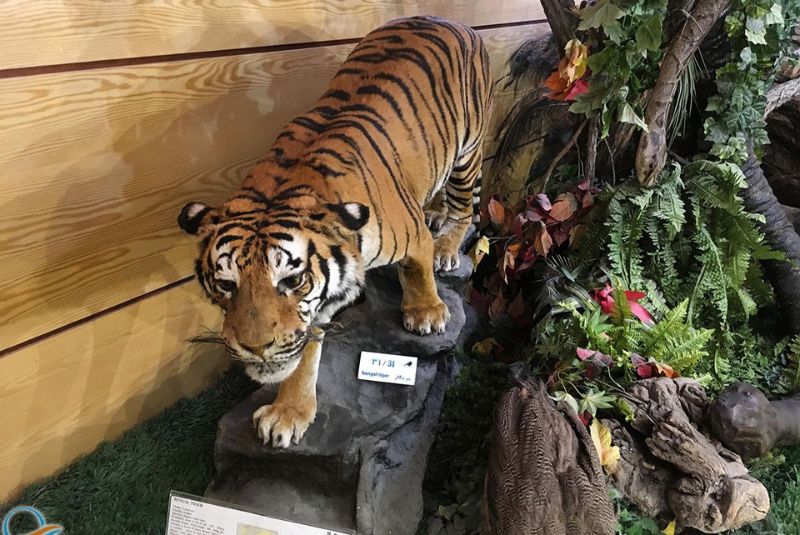
The Darabad Museum of Nature and Wildlife is divided into several diverse sections showcasing Iran's rich biodiversity:
Entrance and Museum Courtyard
Upon entering the museum, visitors are greeted by a lush green space filled with trees, and a beautiful pond takes center stage. The courtyard offers benches for relaxation, inviting visitors to rest amidst nature.
Additionally, a small zoo within the museum courtyard houses animals like peacocks, pheasants, eagles, rabbits, and more, each housed in their respective enclosures.
A notable attraction upon entering the museum is a large statue depicting a herbivorous dinosaur named Camptosaurus. This dinosaur once inhabited Iran during the Jurassic period, with its footprint discovered in Kerman.
The statue, crafted by Iranian and Afghan artists in Yazd, stands at 6 meters long and 7.2 meters tall. Since 2001, it has been a centerpiece at the museum, alongside a fossilized footprint measuring 42 cm in length, 25 cm in width, and 4 cm in depth.
| Suggestion: Tehran Post & Communications Museum
Asia, Europe, and North America Hall
This section displays a variety of biological specimens from Asia, including the world's longest snake, the python, male and female Indian peafowls, Bengal tiger, and other selected species.
In the European and North American section, visitors can see species like the moose (the largest deer in the world), chamois, European red deer, North American brown bear, and Siberian tiger. The bird species here are shared between Asia and Europe.
North Iran Hall
Here, visitors encounter wildlife from the northwestern region of Iran, including species such as Armenian mouflon, roe deer, Persian ibex, wild goat, bezoar goat, flamingo, and others.
This section also features the Caspian seal, which can grow over four meters in length, and species endemic to the Caspian forests. Visitors can also observe urials, a species native to northeastern Iran, alongside taxidermied birds from Iran's native and migratory populations.
| Suggestion: Tehran Museum of Contemporary Art
Central and South Iran Hall
Upon entering, visitors are greeted by some of Iran's rarest and most beautiful mammals, including the Persian leopard and Persian gazelle, both endangered and under protection.
Further exploration reveals the presence of Persian leopards, various fox species, jackals, caracals, and diverse reptiles such as lizards and marmots.
Africa Hall
This section showcases mammals native to Africa alongside migratory bird species from both Africa and Iran. At the entrance, exhibits include African wild buffalo skulls, African elephant tusks, black-necked giraffe, African wild dog, and African leopard.
| Suggestion: Vaziri Caved Museum
Aquatic and Reptile Hall
Divided into two categories, this hall features aquatic animals including freshwater fish from Asia, Africa, and South America, as well as saltwater fish from the Persian Gulf.
The vivid colors and graceful movements of these creatures in their aquatic environments captivate visitors. The reptile section houses venomous and semi-venomous snakes native to Iran, alongside amphibians and taxidermied aquatic species.
Geology Hall
This section presents various geological eras in schematic form and through dioramas. It emphasizes the importance of this era from an Islamic perspective based on Quranic verses. Each diorama showcases the geographical distribution of flora and fauna during different periods of Earth's history.
Additionally, a diverse collection of fossils, some dating back over a billion years, is on display, highlighting their significance in medical, industrial, and construction contexts.
Insect Section
Located in the northern part of the museum grounds, this section is dedicated to familiarizing visitors with various native and non-native butterfly species. In addition to butterflies, it features a variety of beetles, scorpions, and rhinoceros beetles.
This section is divided into eight primary geographical regions based on animal geography to showcase the diversity of butterfly species in different regions.
| Suggestion: Moghadam Museum
Botany Hall
The Botany Hall at Darabad Museum boasts a collection of 600 species of native plants from different regions of Iran. It is divided into phyto-geographical regions including the Hyrcanian, Irano-Turanian, and Persian Gulf-Omani zones. Visitors can view at least 50 endemic Iranian species among the flora displayed.
Taxidermy Workshop
This workshop educates visitors on the preservation and display techniques of non-living organisms. It includes diorama construction, which simulates taxidermied organisms in their natural habitats. The workshop covers various taxidermy processes for birds, mammals, reptiles, amphibians, and insect exuviae.
Specialized Library
As a natural history museum, Darabad aims to expand and strengthen its educational and research departments by forming scientific committees in all relevant fields.
Its specialized library provides books and documents covering a range of environmental topics including zoology, botany, geology, geography, agriculture, livestock breeding, ecology, and conservation.
| Suggestion: Royal Car Museum in Tehran
Recreation at the Darabad Museum of Natural History
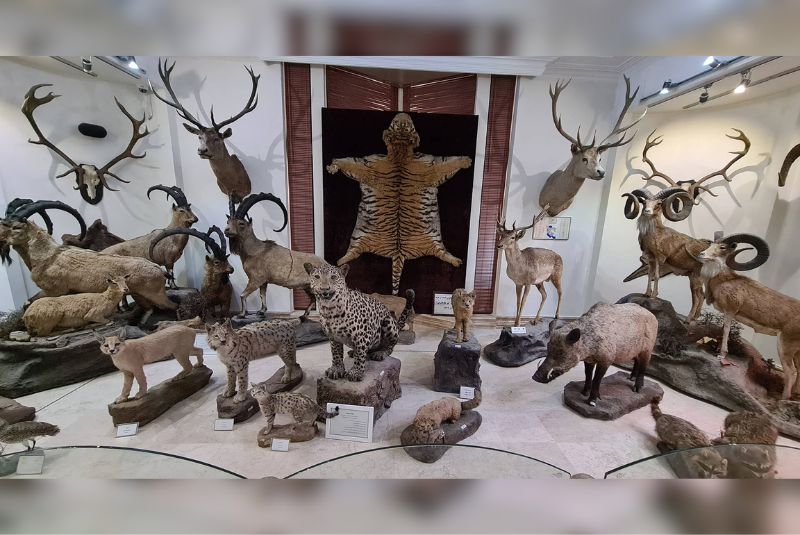
The Darabad Museum of Natural History offers a diverse range of recreational activities that blend education with entertainment, catering to visitors of all ages. Here are some things you can do at the Iran wildlife and nature museum:
6D Cinema Experience
One of the main attractions at the museum is its 6D cinema, located in the halls dedicated to animals from Asia, Europe, and North America. Equipped with 40 seats, this cinema utilizes special effects such as vibration, impact, lateral movement, water spray, and wind gusts to immerse viewers in realistic experiences. The cinema showcases 20 different films, each lasting five minutes, offering an interactive journey through the world of wildlife.
Open-air Cinema and Amphitheater
The museum also boasts an open-air cinema and an amphitheater with a capacity of approximately 70 people. These spaces are ideal for screening educational films about the natural environment, conducting educational classes for different age groups, seminars on environmental issues, and even concerts.
Veterinary Clinic and Pet Shop
Adjacent to the museum, there is a veterinary clinic providing services for the examination and treatment of various domestic animals. The clinic's pet shop offers a variety of pets for sale, including birds, squirrels, rabbits, dogs, cats, and turtles, among others.
Human Park Tehran
The Human Park is hailed as one of Iran's newest and most advanced theme parks dedicated to the human body. Visitors explore enlarged human anatomy and learn about its wonders, making it an educational and awe-inspiring experience for all ages.
Doctorland
Doctorland stands out as a unique hospital-themed amusement park for children, featuring emergency rooms, laboratories, radiology and ultrasound departments, operating theaters, pediatric and neonatal care units, ophthalmology, and dentistry. Children can dress in medical attire and interact with various medical instruments under the guidance of scientific experts.
Dream Park
Dream Park showcases 100 artistic exhibits that captivate visitors' visual senses. Here, visitors can take photos with Arash Kamangir or ride on a bird-shaped carpet. The park encourages creativity and innovation in photography, allowing visitors to print their photos on t-shirts, mugs, or canvases.
Observatory Darabad
The Darabad Observatory is equipped with a sophisticated telescopic system and automatic tracker, boasting two modern, powerful telescopes. It is Tehran's most modern solar observatory, allowing visitors to observe the sun during the day and the moon, planets, and other celestial bodies at night. The museum also hosts Iran's first and only meteorite museum.
| Read more: National Museum of Iran - Iranian Largest Archeological Museum
Opening Hours
The visiting hours for the museum are as follows:
First Half of the Year (Spring and Summer): From 8:00 AM to 8:00 PM.
Second Half of the Year (Autumn and Winter): From 8:00 AM to 6:00 PM
Location of Iran Wildlife and Nature Museum
The iran wildlife and nature museum is one of Tehran's notable attractions, located at the beginning of the Darabad area and Ajudaniyeh Street, on Museum Street. It is situated in a scenic area that makes it a popular destination for both locals and tourists.
| Suggestion: Tehran Time Museum
How to Get There
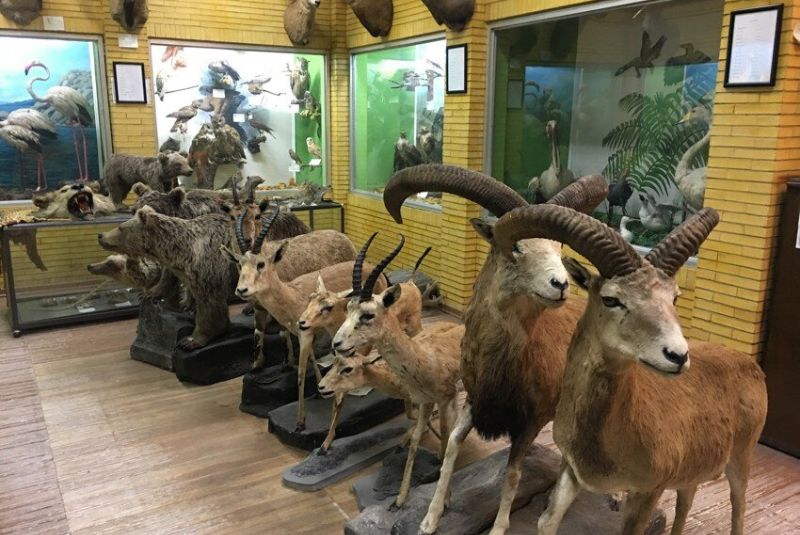
By Metro
The closest metro station to the museum is Tajrish Station, accessible via Line 1. From Tajrish Square, you can take a taxi on the Tajrish-Niavaran-Darabad route. These taxis will take you to the beginning of Museum Street, from where it's a short walk to the museum.
By Bus
Alternatively, you can use the Tajrish-Darabad bus line and get off at the Wildlife Museum stop. From this stop, the museum is just a short walk away. To reach Tajrish Square, in addition to the metro, you can use the BRT (Bus Rapid Transit) line from Rah Ahan to Tajrish.
| Also read about: Tajrish Bazaar - The Beautiful Traditional Market in Tehran
Tourist Attractions Near the Darabad Museum
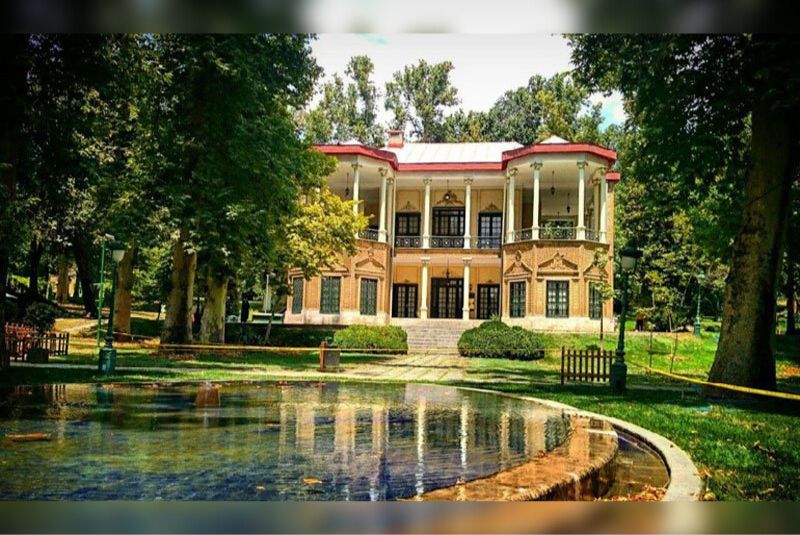
You can plan your itinerary to visit both Darabad Museum of Natural History and nearby attractions in Tehran in a single day. The attractions around Darabad Museum of Natural History include:
- Niavaran Palace
- Mount Darabad
- Stairways of Bagh-e Behesht
- Eyn ol-Dowleh Garden and Mansion
- Darakeh
- Kooshk-e Ahmad Shahi
- Kabootar Khaneh Waterfall
- Bam-e Mah
- Museum of Mir Emad
- Tochal Recreational Complex
- Jamshidieh Park
- Heyran Park
- Kooshk-e Ahmad Shahi
- Darabad Coastal Park
- Bam-e Bookan 2
- Golabdarreh Park
Bottom Line
If you have a passion for animals and a curiosity about nature, a visit to the Darabad Museum of Natural History in Tehran is an absolute must. Established by Tehran’s municipality in 1993, this museum stands as one of the city's most comprehensive centers dedicated to showcasing Iran's rich biodiversity and wildlife.
From scientific workshops and educational courses to captivating exhibitions and live animal displays, every corner of this museum offers a unique and immersive experience.
Share your story!
Comment below and let us know about your Experience.
Your story inspires others!


Comment
Leave a Comment